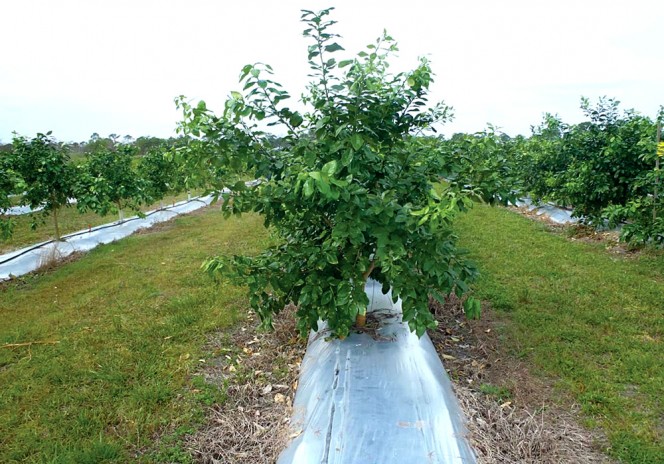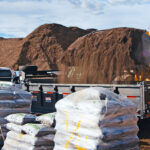Reliable harvest data is still five to six years away, but plots where compost was applied are showing faster, healthier citrus tree growth.
Peter Gorrie
BioCycle November 2015
Early research results suggest compost might lower the stress on trees attacked by a disease that is devastating millions of acres of citrus groves in Florida and elsewhere in the United States and around the globe. Citrus greening or, officially, Huanglongbing (HLB), was first seen in China in 1919 and, after invading the Philippines and South Africa, was confirmed in Florida a decade ago.

Compost is being tested in a grapefruit orchard in trials comparing conventional practice using plastic mulch at the base of the trees (above) versus applying compost as a mulch. After 2.5 years, the trees with compost show, on average, a 38 percent increase in trunk diameter. Photo courtesy of Monica Ozores-Hampton
The disease stunts tree growth and prevents the ripening of oranges, grapefruit and other citrus crops. It is caused by a bacteria spread mainly by a fly known as the Asian citrus psyllid but also by transporting infected fruit and trees. Florida and six other states — Alabama, Georgia, Mississippi, Texas, Arizona and Hawaii — are under quarantine for the disease and the citrus psyllid, as are parts of California, South Carolina and Louisiana, according to the U.S. Department of Agriculture.
Most of the effort to halt its spread is focused on genetic modification and improving the formulation and delivery of pesticides. But Monica Ozores-Hampton, an associate professor in the Horticultural Sciences Department at the University of Florida, is investigating whether adding compost to the poor, sandy soils that underlie most of the state’s citrus groves could help the trees to fend off the disease.
The thin soil wasn’t an issue before the arrival of citrus greening. The groves could rely on heavy applications of chemical fertilizers and pesticides to ensure a good crop, says Ozores-Hampton, whose work, based at the Southwest Florida Research and Education Center in Immokalee, includes support to commodity groups, regulatory agencies, and vegetable growers needing science-based solutions to production problems. “But when you have the disease, it really compounds the impact on the trees,” she adds.
In theory, compost should produce stronger, more resilient trees by improving the soil’s physical, chemical and biological properties, such as moisture retention and efficiency of nutritient use, notes Ozores-Hampton. “You need to optimize everything. You can provide a better environment for the roots, so the plant will be less under threat of greening, by enabling a better root system.” Results of a survey of 32 growers conducted in 2013 by William Castle, a professor emeritus at the University of Florida, suggest that, “maintaining good tree health is important in minimizing (citrus greening’s) impact.”
A small but growing number of growers use compost, mainly produced from biosolids and yard trimmings by the Solid Waste Division of Lee County, Florida (see “Biosolids Compost Manufacturer Taps Agricultural Markets,” August 2015). While they say compost makes a difference, “we don’t have any data,” says Ozores-Hampton. Her trial, on a 2.5-acre grapefruit grove, is intended to provide some hard evidence.
The research plot is the same land where Ozores-Hampton began testing compost on vegetables in 1993. After a few years, she switched to forestry crops, then, sugar cane, before the citrus trials started 30 months ago. In all cases, compost was applied to half the land; the other half received none. The current source is made from leaves and yard trimmings at R&D Soil Builders Inc., in Immokalee.
Long-Term Results
Since citrus trees take at least three years to produce fruit, Ozores-Hampton doesn’t yet have harvest results. But, she says, compost leads to faster, healthier growth. “I have been obtaining an average 37.8 percent increase in trunk diameter in the citrus as the result of compost application. Trunk diameter is highly correlated to citrus yields and is one of the methods to measure productivity.”
Despite the evidence of improved tree health, compost doesn’t eliminate the need for chemical fertilizers or pesticides, she adds. “It didn’t delay the onset of the disease. All the trees got it. Compost is not going to kill the bacteria or the citrus psyllid. You still need to use the same regime. Compost should, however, provide larger and healthier root and canopy systems.”
For the tests, compost was applied to half the trees as they were planted. The soil was then covered in white or metallic plastic mulch over the entire plot. Now, Ozores-Hampton intends to use compost and mulch as the new production system to grow citrus.
However, the future of her research is uncertain. It would take five or six years to get reliable harvest data, but she has funding for only another six months. “It’s difficult to get funding for compost trials,” she says. But she is undaunted: “We’ll see what happens. I’ll figure something out.”
Peter Gorrie is a Contributing Editor to BioCycle.













